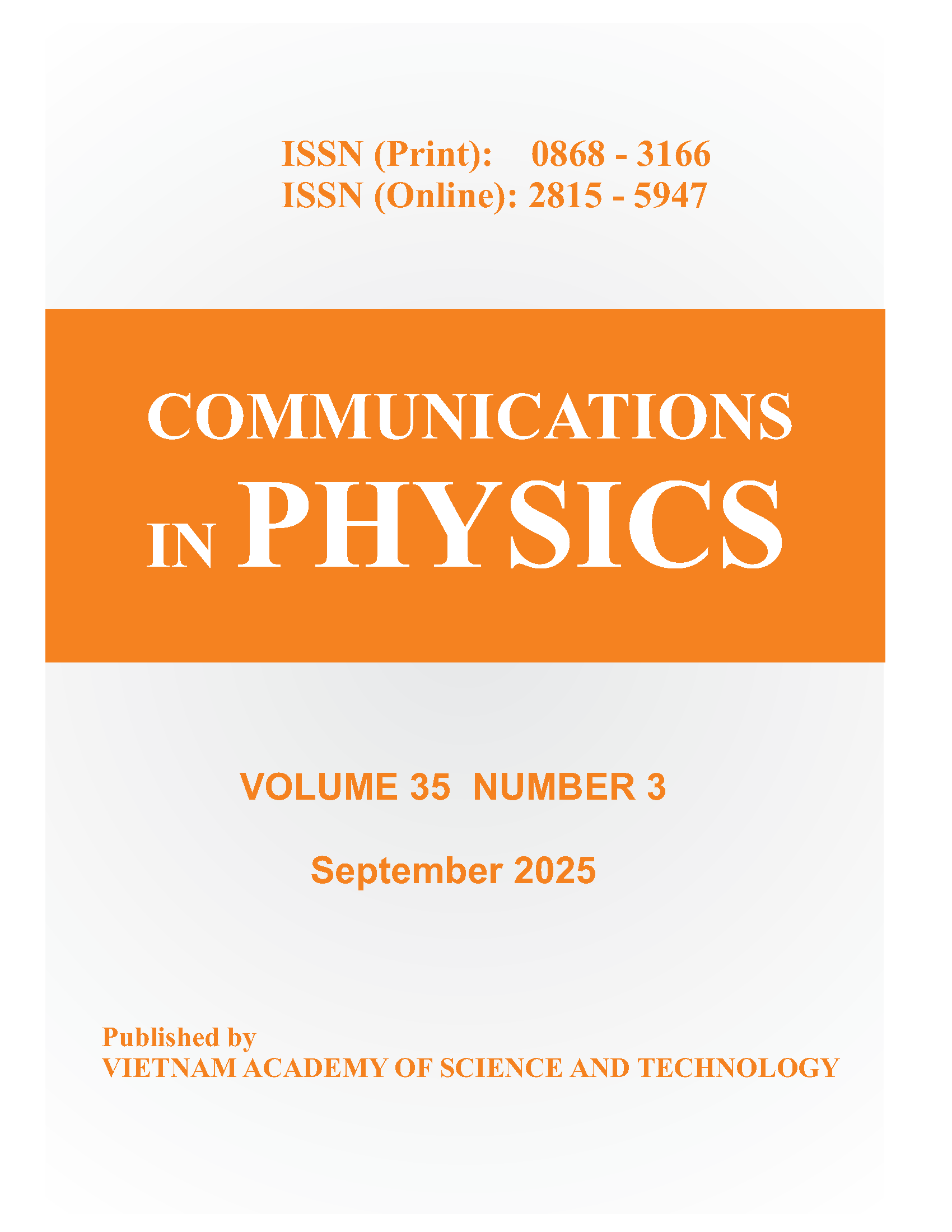A Low Cost Microwave Synthesis Method for Preparation of Gold Nanoparticles
Author affiliations
DOI:
https://doi.org/10.15625/0868-3166/24/2/3809Keywords:
gold nanoparticles, particles size and distribution, microwave synthesis, nanostructuresAbstract
Gold nanoparticles are being used in various biomedical applications due to their small size to volume ratio, extensive thermal stability, less toxic… Many different techniques e.g. chemical, photochemical reduction and electrochemical, gamma have been applied to preparing this nanoparticle. In this paper, we are developing a low-cost technique by using a common microwave system with medium power for synthesizing gold nanoparticles with using sodium citrate (Na3Ct) reduction in chloroauric acid (HAuCl4.3H2O). It was found that the comparing with normal thermal method, the reaction by the microwave irradiation was much faster. Besides, the effects the sodium citrate concentration and optical properties of gold nanoparticles were studied. The optical properties of gold nanoparticles suspension were characterized by using transmission electron microscopy (TEM), X-ray diffraction (XRD), and UV-VIS absorption spectroscopy (UV-Vis). Maximum absorbance wavelengths ( λmax ) for gold nanoparticles are ~ 518-524 nm with the size of 12-25 nm. The size of gold nanoparticles decreases with increasing concentration of sodium citrate. Besides, the morphology of gold nanoparticles have a spherical shape with face-centered-cubic (fcc) crystalline structure.
Downloads
References
P. Raveendran, J. Fu, and S. L. Wallen, A simple and “green” method for the synthesis of Au, Ag, and Au-Ag alloy nanoparticles, Green Chemistry, vol. 8, no. 1, pp. 34–38, 2006.
R Sardar; AM Funston; P Mulvaney; RW Murray, Gold Nanoparticles: Past,Present, and Future, Langmuir, vol. 25, p. 13840, 2009.
Sperling RA, Rivera Gil P, Zhang F, Zanella M, Parak WJ, Biological applications of gold nanoparticles., Chem Soc Rev, vol. 37, p. 1896, 2008.
Boisselier E, Astruc D, Gold nanoparticles in nanomedicine: preparations,imaging, diagnostics, therapies and toxicity., Chem Soc Rev, vol. 38, p. 1759, 2009.
G. C. Schatz, A. A. Lazarides, K. L. Kelly, and T. R. Jensen, Optical Properties of Metal Nanoparticles Aggregates Important in Biosensors, J. Mol. Struc. (Theochem), vol. 59, p. 529, 2000.
Jang-Sik Lee, Recent progress in gold nanoparticle-based non-volatile memory devices, Gold Bull, vol. 43, issuse 3, p. 189-199, 2010.
J. Turkevich, P. C. Stevenson, J. Hillier, A study of the nucleation and growth processes in the synthesis of colloidal gold", Discuss. Faraday. Soc., Vol 11, p55–75, 1951.
M.C. Daniel, D. Astuc, Gold nanoparticles: assembly, supramolecular chemistry, quantum-size-related properties, and applications toward biology, catalysis, and nanotechnology, Chem. Rev. vol 104, p.D293–D346, 2004.
Chien-Jung Huang, Pin-Hsiang Chiu, Yeong-Her Wang, Wen-Ray Chen, and Teen-Hang Meen, Electrochemically Controlling the Size of Gold Nanoparticles, Journal of The Electrochemical Society, vol 153 , no 12,p D193–D198, 2006.
S. Kundu, S. Panigrahi, S. Praharaj, S. Basu, S.K. Ghosh, A. Pal, T. Pal, Anisotropic growth of gold clusters to gold nanocubes under UV irradiation, Nanotechnology, vol 18, no 7, p 075712–075719, 2007.
V.G. Pol, A. Gedanken, J. Calderro-Moreno, Deposition of GoldNanoparticles on Silica Spheres:A Sonochemical Approach, Chem.Material, vol 15, p 1111–1118, 2003.
C.C. Kim, C.H. Wang, Y.C. Yang, Y. Hwu, S.K. Seol, Y.B. Kwon, C.H. Chen, H.W. Liou, H.M. Lin, G. Margaritondo, J.H. Je, X-ray Synthesis of Nickel-gold Composite Nanoparticles, Materials Chemistry and Physics, vol 100, p292–295, 2006.
C.H. Wang, C.J. Liu, C.L. Wang, T.E. Hua, J.M. Obliosca, K.H. Lee, Y. Hwu, C.S.Yang, R.S. Liu, H.M. Lin, J.H. Je, G.Margaritondo, Optimizing the size and surface properties of polyethylene glycol (PEG)-gold nanoparticles by intense x-ray irradiation, J. Phys. D: Appl. Phys, vol 41, p195301, 2008.
R. Sreeja, P.M. Aneesh, A. Aravind, R. Reshmi, R. Philip, M.K. Jayaraj, Size-Dependent Optical Nonlinearity of Au Nanocrystals, J. Electrochem. Soc, vol 156, no 10, p. K167–K172, 2009.
H.M. Kingston, S.J. Haswell, Microwave-Enhanced Chemistry, American Chemical Society,Washington, DC, 2005
S. Komarneni, D. Li, B. Newalkar, H. Katsuki, A.S. Bhalla, Microwave−Polyol Process for Pt and Ag Nanoparticles, Langmuir, vol 18, p5959-5962, 2002.
Fuelong D.N., A. Launikonis & W.H.F. Sasse, Colloidal platinum sols. preparation, characterization and stability towards salt. J. Chem. Soc., Faraday Trans. 1 vol 80, no 3, p 571–588, 1984.
S. K. Seola, D. Kima, S. Junga, Y. Hwu, Microwave synthesis of gold nanoparticles: Effect of applied microwave power and solution pH, Materials Chemistry and Physics vol 131, p331–335, 2011.
N.N Long, L.V. Vu, C. D. Kiem, S. C. Danh, C. T . Nguyet, P. T. Hang, N. D. Thien, L. M Quynh, Synthesis and optical properties of colloidal gold nanoparticles, Journal of Physics: Conference Series, vol187, p 012026, 2009.
Downloads
Published
How to Cite
Issue
Section
License
Communications in Physics is licensed under a Creative Commons Attribution-ShareAlike 4.0 International License.
Copyright on any research article published in Communications in Physics is retained by the respective author(s), without restrictions. Authors grant VAST Journals System (VJS) a license to publish the article and identify itself as the original publisher. Upon author(s) by giving permission to Communications in Physics either via Communications in Physics portal or other channel to publish their research work in Communications in Physics agrees to all the terms and conditions of https://creativecommons.org/licenses/by-sa/4.0/ License and terms & condition set by VJS.











